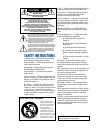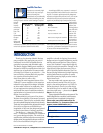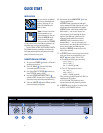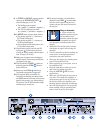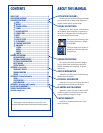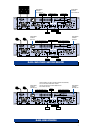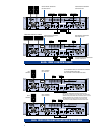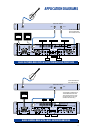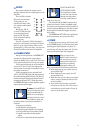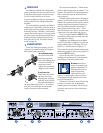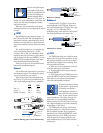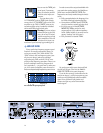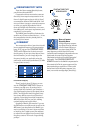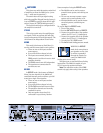
10
Here are some more examples of how you
might use the
GAIN
controls:
• When you are in a small room where loud
volume is not required, having the amp gain
controls turned fully clockwise would require
you to keep the mixer faders down exceptionally
low. In this case, first set the mixer faders to
unity gain, adjust the mixer’s input trim controls
to optimum, then rotate each M•800
GAIN
con-
trol until the desired volume is obtained.
• If you have high efficiency speakers and a
high gain preamp, you may hear “hiss” in your
speakers. This can be fixed by turning the
GAIN
controls down a few notches.
• If you are not blessed with a mixer or
preamp, it is possible to connect a source com-
ponent directly to the amplifier. For example,
you can connect a CD player directly to the in-
puts. You MUST make sure that the amplifier
GAIN
controls are turned down before you
start the CD, then bring them up to a nice
level. This direct connection only applies to
line-level components. It does not apply to
turntables, microphones, or instruments, as
these need preamplification and equalization.
The
GAIN
controls differ in operation be-
tween stereo, dual mono, and bridged modes:
STEREO
and
MONO:
Each control is independent;
CH 1
GAIN
only changes CH 1,
CH 2
GAIN
only changes CH 2.
BRIDGE
:
Only the CH 1
GAIN
control will work
because the CH 2 control is bypassed
internally.
ON
OFF
POWER
PROFESSIONAL POWER AMPLIFIER
FULL SYMMETRY DUAL DIFFERENTIAL HIGH CURRENT DESIGN
OL
–
3
–
6
–
9
–
20
–
3
–
6
–
9
–
20
OL
CH
1
28
26
24
18
20
16
2214
12
6
0
0
1.23v (+4dBu)
SENSITIVITY
GAIN/dB
1.23v (+4dBu)
SENSITIVITY
GAIN/dB
CH
2
NORM HOT
SIG
CH
STAT US
1& 2
3v
2v
1v
28
26
24
18
20
16
2214
12
6
0
0
3v
2v
1v
FEATURE DESCRIPTIONS
LET’S TWIST A GAIN
These are completely independent volume
controls for each channel. Instead of having an
arbitary scale, they are carefully calibrated:
• The inner ring graphic is labeled in dB,
though this indicates the amplifier’s voltage gain,
think of it as increasing decibels from off to 28.
• The outer ring shows the input sensitivity
in volts. This is the amount of voltage required
from a mixer to drive the amp to it’s rated power
output (225 watts into 4 ohms). With the con-
trol fully clockwise, it will require an input level
of 1.23 volts rms to reach rated power. This is
equivalent to putting in a signal level of +4 dBu.
If you have the knob set at 3v, it will require
3 volts from your mixer to reach full power.
This will rob the mixer of headroom, because it
takes extra voltage to drive the amp. Rotating
the knob to 2v means you will need 2 volts from
your mixer, which improves the mixer head-
room. Rotating the
GAIN
control all the way
clockwise provides the best mixer headroom
under normal operation.
Note: The calibration marks only apply to
stereo or mono operation using speakers of
4 ohms impedance.
Like all amplifier controls, you’ll typically
determine the optimal settings during installa-
tion or sound check, then leave them alone,
using your signal source (mixer/preamp) to
control listening levels as you work. Or play.
You may wonder why we didn’t use just one
stereo control to control both sides. That’s in
case your application requires a left/right im-
balance (due to an irregularly shaped room),
an irregularly shaped friend, or if you’re using
the two sides for completely different purposes
(such as monitor in CH 1 and side-fill in CH 2).
28
26
24
18
20
16
2214
12
6
0
0
1.23v (+4dBu)
SENSITIVITY
GAIN/dB
3v
2v
1v



